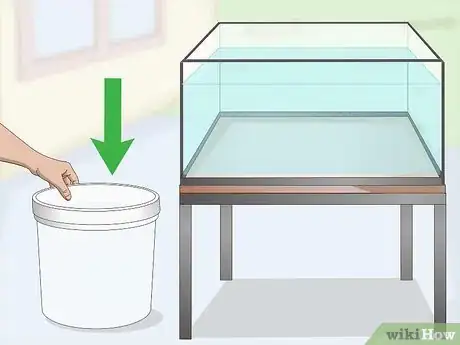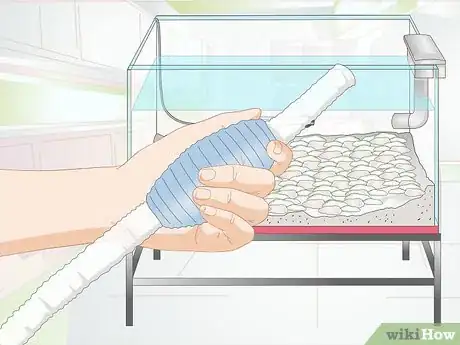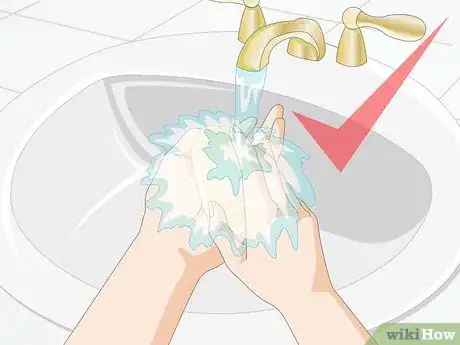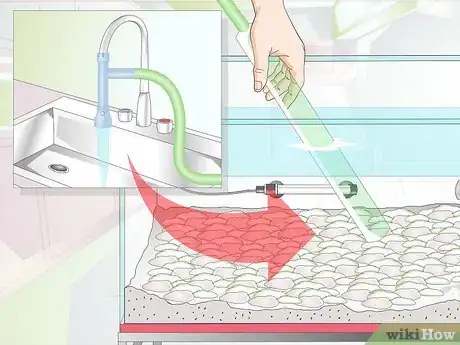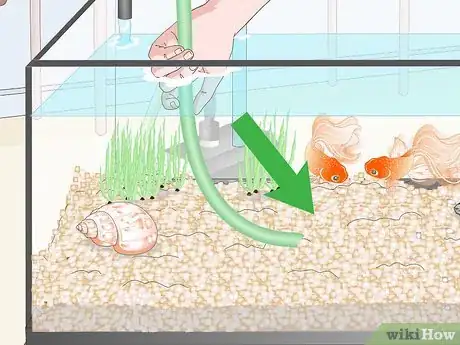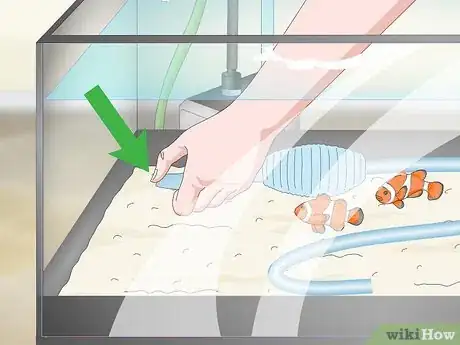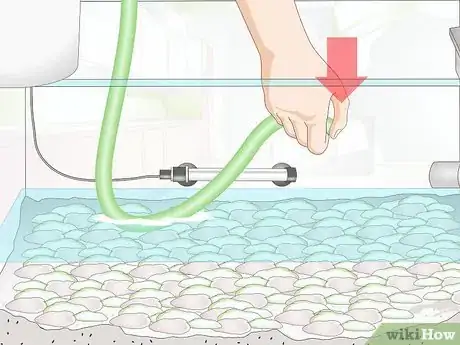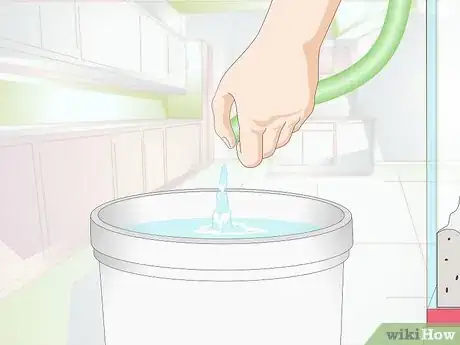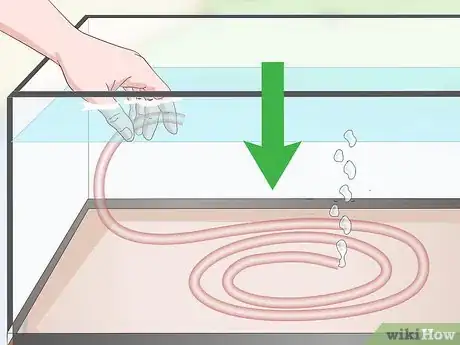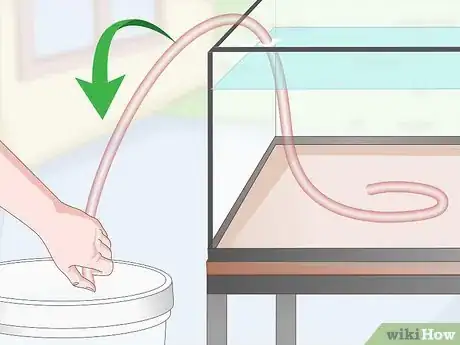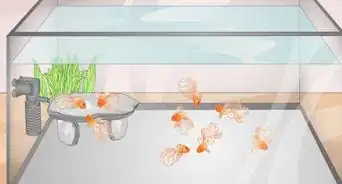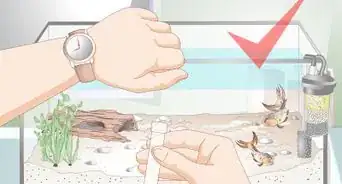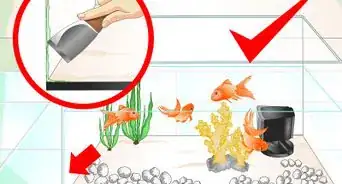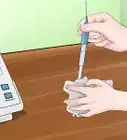This article was co-authored by Pippa Elliott, MRCVS. Dr. Elliott, BVMS, MRCVS is a veterinarian with over 30 years of experience in veterinary surgery and companion animal practice. She graduated from the University of Glasgow in 1987 with a degree in veterinary medicine and surgery. She has worked at the same animal clinic in her hometown for over 20 years.
This article has been viewed 143,719 times.
For optimum fish health, fish tanks must be drained 25% on a weekly basis. This can be done by way of a siphon, and your fish can stay in the tank. A simple aquarium vacuum kit can be purchased at most pet stores. This kit can be used to siphon a tank, using either a “submersion method” or a “suck-start method." Whichever method you choose, siphoning your fish tank is a simple process.
Steps
Getting Started
-
1Obtain a suitable bucket. You are going to need a bucket that can hold a lot of water. However, you must also keep in mind the weight of the bucket when full. For example, a gallon of water weighs a bit over 8 pounds, which means a 5 gallon (18.9 L) bucket full of water would weigh in at 40+ pounds, if completely full.[1]
-
2Procure a vacuum kit. Pet stores selling aquarium supplies often sell inexpensive vacuum kits. These consist of about a 2 inch (5.1 cm) (or larger) diameter by 6 to 18 inch (15.2 to 45.7 cm) rigid plastic tube. This tube will be open at one end, with a 1⁄2 inch (1.3 cm) diameter opening at the other end. Included in this kit will also be a fairly long length of 1/2" clear, flexible tubing. The 1⁄2 inch (1.3 cm) flexible tubing should be of sufficient length to reach from the furthest point inside the tank, over the tank top and downward into the bucket.[2]Advertisement
-
3Connect the vacuum. Connect the wide rigid tube to the 1⁄2 inch (1.3 cm) flexible tube (if not already connected). The object of weekly maintenance is to remove solid waste and change about 25% of the water in the tank. This siphon procedure will do both at the same time.[3]
-
4Wash and rinse your hands well. Before placing your hands in the tank, be sure to thoroughly wash your hands with soap and warm water, and rinse well. Marine life and plants can react negatively to dirt, bacteria, and even soap.
Starting a Siphon by Submersion
-
1Position your bucket. The bucket may be placed anywhere, so long as the top of the bucket is below the bottom of the tank. If the tank is very large, additional tubing and coupling(s) may be required. Cut off any excess tubing, if desired.[4]
-
2Place your siphon tube in the aquarium. Begin by placing the vacuum end (the larger opening) of your tube inside your aquarium. You will want to keep the end of the siphon tube several inches above the gravel. Take the opposite end of your siphon tube, and point it toward your bucket.[5]
- If the siphon you are starting has a “gravel vacuum” attached to it, you can rest the open end on top of the aquarium gravel.
-
3Flood the vacuum and tube. Place the vacuum opening (the larger tube opening) into the fish tank, so that water displaces the air in the tube. Then, slowly lower the remaining length of tubing into the tank. (Water should continue to displace the air from the entire length of the tubing.) If done correctly, there will be very little air left in the tubing.[6]
-
4Seal the discharge opening. Grab the discharge opening (the other, more narrow end of the flexible tube). With the vacuum opening still submerged, seal the discharge opening by pressing a finger over it. Do not break the seal.[7]
-
5Lift the discharge opening. Lift the end of the tube with the discharge opening up and out of the tank. Lower it down into your bucket, maintaining the seal. Make sure the vacuum end is still against the tank bottom, and remove your finger from the discharge end of the tube. Water will begin to flow from the tank into the bucket.[8]
-
6Direct the water into your bucket. Keep the discharge end directed into the bucket, while you gently move the vacuum end around the tank bottom. It may be useful to have a second person on hand to help you.
-
7Stop water flow. When you have removed enough water, you can stop the water flow by raising the discharge end to a point slightly higher than the aquarium.
- You will need to flood the vacuum and tube again if additional siphoning needs to be performed.
Starting a Siphon With Your Mouth
-
1Position your bucket. Another method for starting a siphon it to you use your mouth to initiate the suction. To accomplish this, first place your bucket on a surface lower than your fish tank.
-
2Position the tube. Next, place the vacuum end (larger opening) of your tube at the bottom of your fish tank. Keep the vacuum end a few inches above the gravel, unless you have a gravel vacuum attached. (If using a gravel vacuum, the tube can rest directly on the gravel.)
-
3Initiate suction. To initiate the suction and get the water flowing, place your mouth on the discharge opening (the smaller end of the tube) and suck lightly. Ensure that the end of the tube is lower than the container from which you are siphoning water.
-
4Direct the water into the bucket. As soon as the water begins to flow, quickly remove your mouth and place the discharge opening into your bucket. Then simply allow the water to flow. Move the vacuum end of the tube around the tank to suck up dirt and debris.
-
5Stop the flow. When enough water has been removed, lift the discharge end of the tube so that it is higher than the fish tank. This will stop the flow of water. If you want to siphon more water, you will need to begin the procedure again.
Things You'll Need
- Helper - if the tank is relatively small, it may be possible to keep the discharge hose directed into a bucket while moving the vacuum about the tank. Larger tanks however, will likely require a second person to keep water from spilling and splashing.
- Aquarium vacuum kit - available at most pet stores.
- Bucket or Pail - when doing maintenance cleaning.
References
- ↑ http://www.firsttankguide.net/siphon-start.php
- ↑ http://www.firsttankguide.net/siphon-start.php
- ↑ http://www.firsttankguide.net/siphon-start.php
- ↑ http://www.firsttankguide.net/siphon-start.php
- ↑ http://www.firsttankguide.net/siphon-start.php
- ↑ http://www.firsttankguide.net/siphon-start.php
- ↑ http://www.firsttankguide.net/siphon-start.php
- ↑ http://www.firsttankguide.net/siphon-start.php
- Videos provided by Anders Fishing
About This Article
Siphoning your tank will keep it clean and help your fish stay healthy in the long run. You’ll need a large 5-gallon bucket and an aquarium vacuum kit. To start, you’ll need to place one end of the siphon tube in the aquarium and one end in the bucket. Place the vacuum opening into the fish tank, then slowly lower the remaining length of tubing into the tank, which will remove any air from it. Then, lift the discharge opening and move it over your bucket. Once the bucket is full of water, raise the discharge end to a point higher than your aquarium to stop it. To learn how to start a siphon with your mouth, read more from our Veterinary co-author!
